
|
German Monster Cannon Or Mortar
|
|
German monster cannon or mortar, manufactured of iron bars, which being placed lengthwise from end to end are fastened by circles of iron. This cannon 7 feet 10 inches in length and 3 feet 6 inches in diameter, has a shield placed between the handles. The shape f which indicates the beginning of the 14th century. In the Imperial Arsenal of Vienna. |
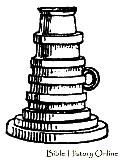
|
14th Century Mortar
|
|
14th century mortar, made of forged iron, with rings but without trunnions. In the Epinal Museum. |

|
Stone Mortar
|
|
Stone mortar from the siege of Waldshut (1448). |

|
Mortar With Trunnions
|
|
Mortar with trunnions, made of forged iron, 2 feet 8 inches in length and about 1 foot in diameter. Because of its trunnions it cannot be from earlier than the beginning of the 15th century. In the Arsenal of Berlin. |
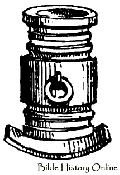
|
Bronze Mortar With Ring
|
|
Bronze mortar with ring but without trunnions, from end of the 15th century. It was found in the drawings made by Glockenthon of the armor contained in the arsenals of the Emperor Maximilian I (1505). In the Ambras Collection. |

|
English Breech-Loading Cannon
|
|
English breech-loading cannon, made of forged iron, open at both ends. From the battle of Crécy (1346). |

|
Breech-Loading Cannon Open At Both Ends
|
|
Breech-loading cannon, open at both ends. The butt or recoil piece was lowered during the loading. From a manuscript of the 14th century. |
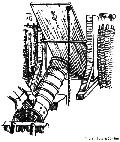
|
Blind Or Mantlet To Breech-Loading Cannon
|
|
Blind or mantlet to a breech-loading cannon, from the second half of the 14th century. |

|
Breech Loading Cannon
|
|
Breech loading cannon from a 15th century manuscript. In the Ambras Collection. |

|
Flemish Breech Loading Cannon
|
|
Flemish breech-loading cannon. The fire chamber screws into the barrel, is of forged iron, made at Ghent between 1404 and 1419. |

|
German Cannon Cast In Bronze
|
|
German cannon cast in bronze, of the 15th century. Length is 12 ft and the diameter 2. The cannon bears a German inscription: My name is Catherine, beware of my contents. I punish injustice. George Endorfer cast me. Also: Sigismund, Archduke of Austria, anno 1404. Now in the Museum of Artillery in Paris. |

|
Wrought-iron Cannon Taken At The Battle Of Grandson
|
|
Wrought-iron cannon taken at the battle of Grandson (1476). The length is 4 feet 8 inches, the diameter is 2 inches, and there are no trunnions. In the Museum of Lausanne. |

|
Breech-Loading Cannon Of The 15th Century
|
|
Breech-loading cannon, wrought iron, 15th century. Taken from the Mary Rose, a ship sunk at the beginning of the 16th century. In the Tower of London. |

|
Wrought-Iron Cannon From The Battle Of Grandson
|
|
Wrought-iron cannon from the battle of Grandson (1476). Length 4ft 6 inches, diameter 1 foot 8 inches. In the Museum of Lausanne. |

|
Burgundian Wrought-Iron Cannon With Wheeled Gun Carriage
|
|
Wrought-iron cannon or mortar, with wheeled gun-carriage, from the battle-field of Morat (1476). The length of the cannon is 2 feet 6 inches, the diameter 8 inches, the gun carriage is 2 yards long and the granite ball or shot 10 inches in diameter. This Burgundian cannon has no trunnions. In the Gymanisum of Morat. |

|
Breech-Loading Cannon With Wheeled And Roofed Gun-Carriage
|
|
Breech- loading cannon with wheeled and roofed gun-carriage, without trunnions. From end of the 15th century. |

|
Breech-Loading Wrought Iron Cannons
|
|
Breech-loading wrought iron cannons without trunnions. From the Chateau de Sainte Ursane Switzerland, where it was placed after the battle of Morat (1476). |
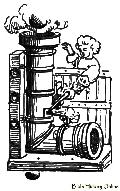
|
German Elbow Shaped Cannon
|
|
German, elbow-shaped mortar or cannon, of the 15th century. With movable chamber and breech-loading, from the engravings of the Institutionum Reiplublicae Militaris by Nicolai Marescalchi, printed at Rostock 1515, in the Hauslaub Library in Vienna. |

|
Italian Elbow-Shaped Mortar Or Cannon
|
|
Italian elbow-shaped mortar or cannon, from the 15th century. Breech-loader with movable chamber; from Martinus Jacobus, De machinis libri decem, 1449. |

|
15th Century Breech-Loading Cannon
|
|
15th century, breech-loading cannon. Manuscript in the Hauslaub Library in Vienna. |

|
Wrought-Iron Cannon With Movable Chamber And Trunnions
|
|
Wrought-iron cannon with movable chamber and trunnions. In the Museum of Artillery in Paris. |

|
English Cannon With Movable Chamber
|
|
English cannon with movable chamber, of the 15th century. |

|
15th Century Wrought-Iron Cannon With Movable Chamber
|
|
15th century wrought-iron cannon with movable chamber. In the Tower of London. |

|
15th Century Cannon With Movable Chamber
|
|
15th century cannon with movable chamber. From a manuscript in the Ambras Collection, Vienna. |

|
German Gun Carriage
|
|
German gun carriage fitted with small cannons. |

|
German Muzzle Loading Cannon
|
|
German muzzle loading cannon. Still without trunnions but has a toothed rack for raising and depressing the cannon. |

|
German Muzzle Loading Culverin
|
|
German muzzle loading culverin. Still without trunnions, but on a movable gun carriage with toothed rack. |

|
Burgundian Muzzle Loading Cannon
|
|
Burgundian muzzle loading cannon, without trunnions but on a movable gun-carriage with toothed rack. This weapon was brought from the field of Nancy (1477)and is at present at Neuveville. |

|
15th Century English Muzzle Loading Cannon
|
|
15th century English muzzle loading cannon. In the Tower of London. |

|
English Muzzle Loading Cannon Without Trunnions
|
|
English muzzle loading cannon, without trunnions, on a grooved rack. |

|
15th Century German Muzzle Loading Cannon
|
|
15th century German muzzle loading cannon, without trunnions. In the Hauslaub Library in Vienna. |

|
Swiss Cannon Rammer
|
|
15th century Swiss cannon rammer called lanterne. Made of copper, on a long shaft, the end of which contains the wadding screw. In the Arsenal of Soleure. |

|
German Serpentine Cannons
|
|
German serpentine cannons, made of wrought iron. Each with five muzzle loading barrels from the middle of the 15th century. In the Museum of Sigmaringen. |
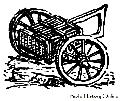
|
German Serpentine Organ With Forty Cannons
|
|
German serpentine organ with forty cannons. Drawn in 1505 by Nicholas Glockenthon. In the Ambras Collection. |

|
15th Century Cannon With Trunnions
|
|
15th century cannon with trunnions. |

|
German Cannon With Separate Chamber And Trunnions
|
|
German cannon with separate chamber and trunnions. From the drawings by Glockenthon. In the Ambras Collection. |

|
Two Small Iron Cannons
|
|
Two small iron falconets or cannons, with trunnions, from the drawing by Glockenthon. In the Ambras Collection. |

|
16th Century Breech-Loading Cannon
|
|
16th century, breech-loading cannon with trunnions, from a manuscript of Senftenberg, a commander of artillery at Dantzic. |

|
Muzzle Loading Cannon With Trunnions
|
|
Muzzle-loading cannon with trunnions. |

|
Serpentine Organ With Forty Two Cannons
|
|
17th century serpentine organ with forty two cannons. To be fired six at once. In the Arsenal of Soleure. |

|
Small Swedish Muzzle Loading Cannon
|
|
Small Swedish muzzle loading cannon, with trunnions, 17th century. Length 3 feet 8 inches, diameter 4 inches. The barrel is formed of thin copper tube, wired outside and the whole covered with leather. In the Arsenals of Berlin and Hamburg, Museum of Artillery in Paris and collection of the King of Sweden. |

|
Muzzle Loading Cannon
|
|
Muzzle loading cannon, with trunnions, made of a tube of copper encased in a thick coating of lime and the whole covered with leather. This was a light weapon and easy to carry in mountainous districts. In the Arsenal of Zurich. |

|
17th Century Swiss Breech-Loading Serpentine Cannon
|
|
17th century, Swiss breech loading Serpentine cannon. In the Arsenal of Soleure. |

|
Swiss Breech Loading Serpentine Cannon
|
|
Swiss breech loading Serpentine cannon, with the makers name, Zell Blasi, 1614. In the Arsenal of Bale. |

|
Small Swiss Copper Cannon
|
|
Small Swiss copper cannon. Adapted for firing ten successive charges. The length is 27 inches and it bears the signature of Welten, Inventor, 1742. In the Arsenal of Zurich. |
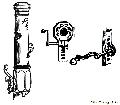
|
Breech Loading Cannon Of The 18th Century
|
|
Breech loading cannon of the 18th century. From the memoirs of Colonel Wurstemberger. |

|
Paixhans Howitzer Cannon
|
|
Paixhans howitzer cannon. Invented by H.C. Paixhans. |

|
Armstrong Gun
|
|
Armstrong gun, 600 lb projectile. Invented by Sir William Armstrong & Co. |

|
Large Breech Loading Prussian Cannon
|
|
Large breech-loading Prussian cannon, of steel cast in the foundry of M. Krupp, exhibited in Paris in 1867. It weighs under 50 tons and the shot 1192 pounds. |

|
Prussian Rifled Field Piece
|
|
Prussian rifled field-piece, loaded at the breech. It is of cast steel and was invented by M. Krupp. |

|
Breech Of Prussian Rifled Field Piece
|
|
Breech of Prussian rifled field piece. The closing is effected by means of a lateral shield, which is pressed by turn of a key and the breech closed at the moment of firing. |



















































